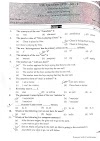Scalars and Vectors
Scalar:
A physical quantity that is completely described by its magnitude is a scalar.
Examples: mass, distance, speed etc.
Vector:
A physical quantity having both magnitude and direction is a vector.
Examples: weight, displacement, velocity, momentum etc.
Elementary area, elementary volume, elementary length, elementary current, etc. can be regarded as vectors.
A quantity having both magnitude and direction may not be a vector. To be a vector, it should follow the laws of vector addition as well.
Examples: time, surface tension, electric current, etc.
All potentials, all fluxes, and energy are scalars.
Examples: Electric Potential, Magnetic Potential, Gravitational potential, electric flux, magnetic flux, kinetic energy, magnetic energy etc.
All flux densities, scalar gradients, field strengths/ intensities, and dipole moments are vectors.
Examples: Electric flux density, temperature gradient, gravitational field intensity, etc.
Polar vectors: Vectors associated with linear directional effect
Examples: Force, momentum, velocity, displacement acceleration etc.
Axial vectors: Vectors associated with rotation about an axis.
angular displacement, angular velocity angular acceleration, moment of force, angular momentum, etc.
Unit vector: A vector with unit magnitude is unit vector.
A unit vector is unitless and dimensionless. It possesses the only direction.
Null vector: A vector with zero magnitude is null vector.
It has arbitrary direction
Laws of vectors
- Triangle Law of Vector Addition
when two vectors are represented as two sides of the triangle with the order of magnitude and direction, then the third side of the triangle taken in reverse order represents the magnitude and direction of the resultant vector.
Parallelogram law of Vector Addition
when two vectors are represented as two adjacent sides of the parallelogram both pointing away from the common vertex, then the resultant is represented by the diagonal of the parallelogram passing through the same common vertex.
Polygon law of vector addition
It states that if a number of vectors can be represented in magnitude and direction by the sides of a polygon taken in the same order, then their resultant is represented in magnitude and direction by the closing side of the polygon taken in the opposite order.
Lami's Theorem It states that, if three coplanar vectors act at a point, then, their magnitude is proportional to the sine of angle between other two vectors.
Algebra of Vectors
Addition of Vectors
If and be any two vectors inclined at angle . Then, is the resultant of two vectors which makes an angle with angle
Magnitude and direction of
Magnitude of
Direction of ,
Cases
If
If
If if and if
If ,
Limits
Difference of Vectors
The difference of two vectors and is denoted by . is the difference of two vectors which makes an angle with angle
Magnitude and direction of
Magnitude of
Direction of ,
Cases
If if and if
If
If
If ,
Limits
Resolution of Vectors
A vector can be resolved into any number of components. But, it has 2 rectangular components in plane and 3 rectangular components in space.
The component of the vector is a vector.
The rectangular component of the vector can never be greater than the vector itself.
For
Horizontal Component:
Vertical Component:
If the components are given then
where is angle with horizontal.
Product of Vectors
Scalar Product
The scalar product of and inclined at angle is given by:
Scalar product of two vectors is the product of vector and projection of second vector in it.
when
when
when
Limit:
Scalar product of vectors results in scalar.
Scalar product is commutative i.e.
If components are given:
Examples:
Vector Product
The vector product or cross product of and inclined at angle is given by:
is the unit vector perpendicular to the plane containing and
Magnitude of vector product of two vectors gives the area of parallelogram which has two vectors as adjacent vectors.
when
when
Limit:
Vector product of vectors results in vector.
Vector product is not commutative i.e.
If components are given:
Examples:
Projection of Vectors
The projection of on is
We know,
Hence,
The projection of on is
The projection of on is
Better You Know
and be any two vectors then
when
when
when
when
when
when
when
when
when
Let and be any two vectors then
The angle between and is
Examples of the scalar product
Work done =
Power =
Electric flux =
Magnetic flux =
Examples of the vector product
Torque =
velocity =
Angular momentum =
centripetal acceleration =
tangential acceleration =
Let and be unit vectors along x-axis, y-axis and z-axis respectively. Then,
Minimum number of
non zero collinear vectors giving zero resultant is 2.
noncollinear coplanar vectors giving zero resultant is 3.
non-coplanar vectors giving zero resultant is 4.
If then
Area of Parallelogram and Triangle
The area of having and as is
The area of having and as is
The area of having and as is
For three vectors of a different magnitude to be able to give zero resultant, they should form a triangle. i.e.
The largest magnitude should be greater or equal to the sum of the other two magnitudes.
eg, The vectors with magnitudes can not give zero resultant.
and, The vectors with magnitudes may give zero resultant.
A vector of magnitude A is rotated by angle then, the change is vector is





![[UPDATED] New Syllabus of IOE Entrance Examination |](https://blogger.googleusercontent.com/img/b/R29vZ2xl/AVvXsEj5C60n4l8guBTBqS4sBFaD1z9AoLPnKFQB_f1-F731bzrW_xcCsoewcBcUtqnpJhlf7lL5sOklAtsxRKdgZ-dCQiAgQb1T2X9ck-D_FYoU01fPdPA0mbsulZgmnkS-6-3Hg_CbxBExwn3z5c3-8srStMoZwr6SrmsgF5fPGjnD29T_lg1XsX3aZoIQm9k/w680/pic.png)


![[UPDATED] New Syllabus of IOE Entrance Examination |](https://blogger.googleusercontent.com/img/b/R29vZ2xl/AVvXsEj5C60n4l8guBTBqS4sBFaD1z9AoLPnKFQB_f1-F731bzrW_xcCsoewcBcUtqnpJhlf7lL5sOklAtsxRKdgZ-dCQiAgQb1T2X9ck-D_FYoU01fPdPA0mbsulZgmnkS-6-3Hg_CbxBExwn3z5c3-8srStMoZwr6SrmsgF5fPGjnD29T_lg1XsX3aZoIQm9k/w100/pic.png)
0 Comments